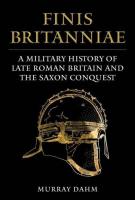
Amberley (2024) h/b 234pp £22.99 (ISBN 9781398118270)
So how did the Romans end their rule of Britain? With a sudden bang, on the dot of AD 410, or with a whimper? Was it like the fall of Saigon or Kabul, soldiers scrambling desperately for the last boats? Or was it a more gradual retreat, town by town, fort by fort, as Rome steadily withdrew its legions to defend the empire closer to home?
Historians don’t have much to go on. There’s little enough agreement on even the most basic fifth and sixth century chronology. Some historians were writing hundreds of years after the actual event, or like Procopius, were working in Constantinople on the other side of the known world. Or they were aware of some earlier histories but not others. Take your pick from Eutropius, Victor, Orosius, Zosimus, Henry, Nennius, Gildas and Bede, the Anglo-Saxon Chronicle, and Henry of Huntingdon: most of them are contradictory. There’s simply no stand-out authoritative account.
In this new study Murray Dahm does his best to pick his way between the more likely reports and dates. For a military historian this must have been especially frustrating. We know of at least thirty important battles but have no idea when or where they were actually fought. Constantius Chloros won his battle for London against Allectus (around 296/7) somewhere ‘between Silchester and Staines’. The great battle of Mount Bladon in the early sixth century might in fact have been fought anywhere in England, Wales or Scotland. (The famous Rescript of Honorius advising British cities to look out for themselves could even have been referring instead to the towns of the Bruttii in southern Italy.)
Archaeological finds tell us much more, and are, as D. acknowledges, becoming increasingly important in constructing the picture of a more nuanced, slower-paced withdrawal: time and again a new excavation shows us Roman life lasting long after 410. Their forts and ports continue to be occupied; their villas and garrison towns can be seen surviving into the 420s and beyond.
Some things do become clearer from D.’s account. Roman Britain was a very remote province of the empire, and thus all the more likely to secede or to become the power centre of local commanders ambitious for the purple. There were revolts in the later years of the third century and at frequent intervals in the fourth, long before 410. We read of a breakaway Imperium Britanniarum in 286 that lasted six or seven years.
And it didn’t all end with one single comprehensive Saxon invasion. There were Saxon incursions from the late 300s onwards as the Romans drew down their garrisons: we find that Saxon forces were often invited over the North Sea to help defend or support rival chieftains. There were Saxons fighting alongside Scots and Picts in the late fourth century, and then Saxons helping Vortigern to defeat those same Picts in the middle of the fifth century.
Nor was Britain the only province under pressure as successive emperors dealt with revolts along the Danube, closer to home. There were Saxon invasions of northern France, barbarian tribes attacking across the Rhine, and Vandals invading Spain. And Constantinople didn’t entirely neglect the calls for help, sending significant reinforcements to Britain on at least two occasions.
But the end did come, even if there was no formal withdrawal. AD 410 seems as good a bookend as any other, and matches the date of Alaric’s sacking of Rome itself. By then D. reports Roman units in Britain under strength, poorly recruited, and dealing with repeated Pictish attacks. As Roman law and order disintegrated, local rulers like Vortigern asked Angles and Saxons for help. Petty kingdoms based on individual towns succeeded tribal domains. The 5th and 6th centuries saw a series of battles across Kent, Sussex and the west country.
From then on the mists descend again. There are glimpses in D.’s final chapter of more distant figures, Kings such as Aelle, Natanleod, Hermegisclus and Ethelbert, who were involved in almost continuous fighting. King Ceolwulf, for example, reigned fourteen years in Wessex, ‘through all of which he was engaged in wars, either with the English, or the Scots, or the Picts’.
D. closes with St Augustine’s arrival in Kent in 597. Sadly King Arthur, often portrayed as England’s national champion in these tumultuous years, only merits an appendix. D. believes, like most, that he was an amalgam of several historical figures: the sources for him are about four hundred years after his putative period.
This cannot, in any sense, be a definitive account of the end of Roman Britain. There simply isn’t sufficient literary evidence and credible history to weigh with the archaeology and the coinage. We will likely always know far more about Britain in the first two centuries AD than in the succeeding four. But D.’s book does give us glimpses into those mists, not least into the arrival of those waves of Europeans—Angles, Saxons, Frisians and Jutes—who were as important as their Roman predecessors in shaping medieval Britain.
Sir Michael Fallon
Founder of the All-Party Classics Group in Parliament
